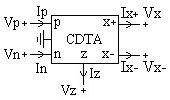Current differencing transconductance amplifier

Okay, imagine you are in a race and you have a friend coming along with you. Your friend is really good at running, but you are not so good. So, you decide to work together to win the race. You tell your friend to go slow while you run as fast as you can. Then, you tell your friend to run as fast as they can while you slow down. This way, you both cover more distance together and can win the race.
Similarly, a current differencing transconductance amplifier (CDTA) works on the principle of teamwork. It has two inputs for current and produces an output voltage. One of the inputs receives a current while the other input delivers an equal and opposite current. These currents work together to provide a larger output voltage that is proportional to the difference between the two input currents.
To simplify it further, think of CDTA as two friends working together – one runs fast while the other runs slow, and they switch roles to win the race. The CDTA does the same by combining two input currents that work together to produce a larger output voltage signal.
CDTAs are used in many electronic devices, such as filters, oscillators, and amplifiers. They work effectively because they can handle large input signals and produce accurate output signals, even in noisy environments.
Similarly, a current differencing transconductance amplifier (CDTA) works on the principle of teamwork. It has two inputs for current and produces an output voltage. One of the inputs receives a current while the other input delivers an equal and opposite current. These currents work together to provide a larger output voltage that is proportional to the difference between the two input currents.
To simplify it further, think of CDTA as two friends working together – one runs fast while the other runs slow, and they switch roles to win the race. The CDTA does the same by combining two input currents that work together to produce a larger output voltage signal.
CDTAs are used in many electronic devices, such as filters, oscillators, and amplifiers. They work effectively because they can handle large input signals and produce accurate output signals, even in noisy environments.
